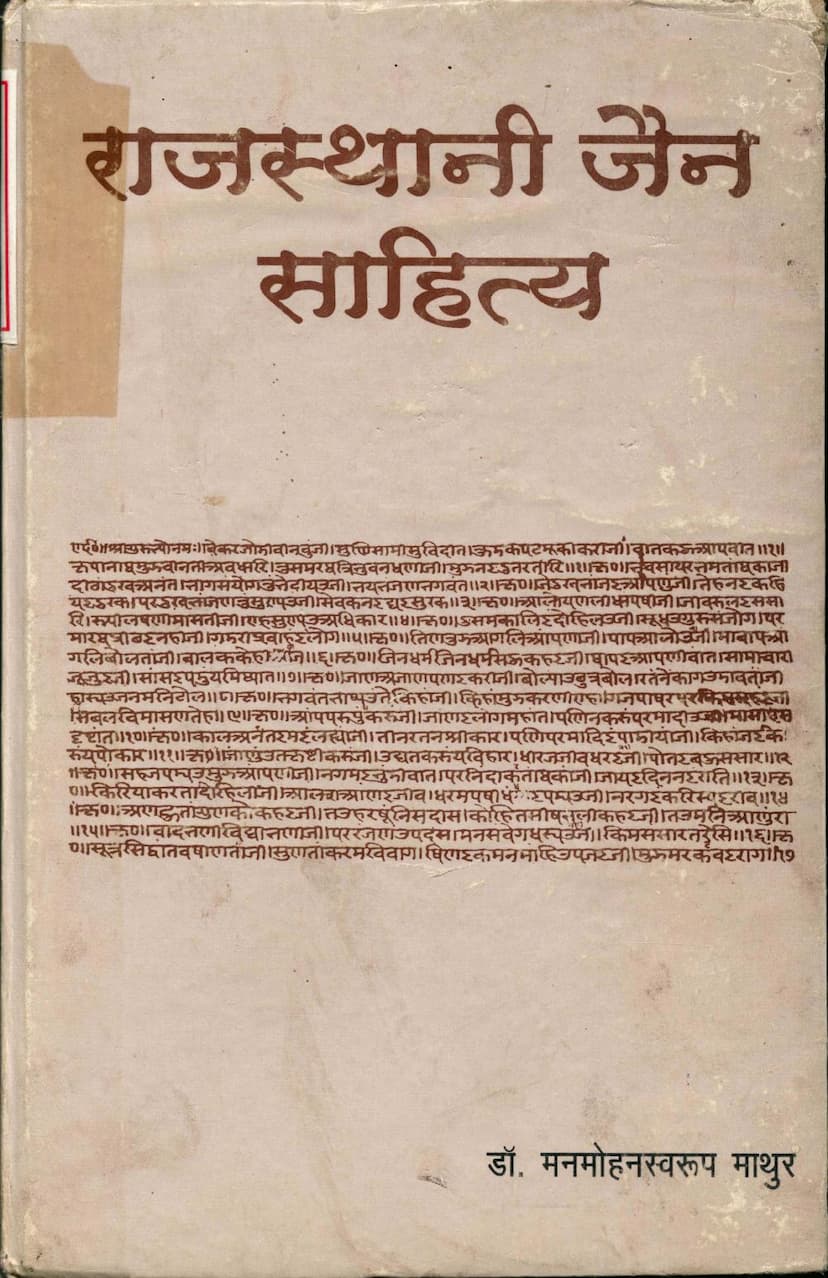Rajasthani Jain Sahitya
Added to library: September 2, 2025

Summary
Here is a comprehensive summary of the Rajasthani Jain Sahitya book, based on the provided pages:
Book Title: Rajasthani Jain Sahitya (राजस्थानी जैन साहित्य) Author: Dr. Manmohan Swaroop Mathur Publisher: Rajasthani Granthagar, Jodhpur Edition: First Edition, 1999 Price: Rs. 150.00
This book is a collection of eleven research articles by Dr. Manmohan Swaroop Mathur, an Assistant Professor in the Rajasthani department at Jai Narain Vyas University, Jodhpur. The collection aims to shed light on the rich and diverse literary contributions made by Jain scholars and poets in the Rajasthani language.
Core Thesis and Scope:
The author's primary focus is on the Rajasthani literature created by Jain authors. While acknowledging that Jain literary tradition spans across Sanskrit, Prakrit, and Apabhramsa, this collection specifically delves into the vast body of work produced in Rajasthani. This focus is justified by the significant volume and cultural importance of Rajasthani Jain literature, which offers profound insights into Jain religious thought, philosophy, and societal practices.
Key Themes and Content of the Articles:
The book systematically explores various facets of Rajasthani Jain literature:
-
Nature of Rajasthani Jain Literature: The first article establishes the scope and characteristics of Rajasthani Jain literature, highlighting its religious nature and the role of Jain monks and ascetics in its creation. It emphasizes the aim of promoting Shraman culture and the use of popular folk tunes and melodies in its dissemination.
-
Social History in Medieval Rajasthani Jain Works: This article analyzes social aspects reflected in Jain literature between 1600 and 1900 AD (Vikram Samvat). It discusses the portrayal of the caste system, family life, rituals (like birth and marriage), societal norms, women's status, and prevailing beliefs. The author uses specific examples from texts to illustrate these points, showing how Jain literature serves as a valuable source for understanding the social fabric of that era.
-
Musical Elements in Rajasthani Jain Poetry: This section explores the integration of music and various ragas (melodies) and talas (rhythms) in Jain poetic compositions. It identifies classical ragas and folk tunes used by Jain poets to make their religious and didactic poetry accessible and engaging to the masses. The article demonstrates the poets' knowledge of musicology.
-
Jain Love-Romances (Premakhyanak Rachanaen) in Rajasthani: This article examines the genre of love stories within Rajasthani Jain literature. It traces the tradition of love narratives in Indian literature, from Vedic times through Sanskrit and Prakrit/Apabhramsa, and highlights how Jain authors adapted these stories, often imbuing them with Jain ethical principles like chastity (sheel). The article analyzes several prominent examples of Jain Premakhyan, such as those involving Sthulibhadra, Neminath, Vidyavilas, and others.
-
Jain Goddesses and Related Jain Compositions: This article discusses the concept of Jain goddesses, their worship, and the literary works dedicated to them. It explains how Jainism, while primarily focused on the liberated souls (Jinas), also incorporated the worship of certain deities, influenced by broader Indian traditions. The article details the roles of various Jain goddesses, their patronage by Tirthankaras, and lists devotional compositions like hymns, verses, and narratives dedicated to them.
-
The Story of Sthulibhadra and its Rajasthani Works: This article focuses on the significant Jain narrative of Sthulibhadra, a disciple of Bhadrabahu and a key figure in Jain tradition. It details the traditional story and then discusses the various Rajasthani literary works that have been based on this narrative, highlighting the adaptations and contributions of different Jain poets.
-
Major Jain Poetic-Scholarly Works in Rajasthani: This section focuses on Rajasthani Jain contributions to poetics and literary theory (Kavya Shastra). It discusses the influence of Prakrit and Apabhramsa scholarly works on Rajasthani Jain authors and highlights the importance of treatises on prosody (Pingal) and rhetoric. It examines works by notable scholars like Kushallabh and the Bhandari brothers.
-
Prominent Jain Poets of Nagaur Region and Historical References in Their Works: This article delves into the literary history of the Nagaur region in Rajasthan, identifying key Jain poets and analyzing the historical, cultural, and social information embedded in their writings. It provides biographical details of poets and discusses their works in the context of the region's history and development.
-
The Tradition of Agaddatta Story in Jain Literature and Kushallabh's Agaddatta Rasa: This article explores the narrative of Agaddatta, a significant figure in Jain lore, and its evolution across various Jain literary traditions. It then provides a detailed analysis of Kushallabh's Agaddatta Rasa, a prominent Rajasthani rendition of this story, comparing it with earlier versions and highlighting Kushallabh's unique contributions.
-
Vachak Kushallabh's Contribution to Jain Literature: This comprehensive article pays tribute to Vachak Kushallabh, a pivotal figure in Rajasthani Jain literature. It discusses his life, patronage, and a wide range of his literary output, encompassing love romances, devotional works, poetic treatises, and historical narratives. It emphasizes his role in refining and popularizing various literary genres and his contribution to the development of Rajasthani language and literature.
-
Terapanth: Composers and Compositions: This article introduces the Terapanth sect within Jainism, its origins, founders, philosophical tenets, and key Acharyas. It then focuses on the literary contributions of Terapanth saints and scholars, presenting examples of their works in Rajasthani that articulate the sect's beliefs and practices.
Overall Significance:
The book "Rajasthani Jain Sahitya" by Dr. Manmohan Swaroop Mathur is a valuable scholarly work that systematically compiles and analyzes the rich literary heritage of the Jain community in Rajasthan. It underscores the significant cultural, religious, and historical insights available within this body of literature, making it an essential resource for scholars of Jainism, Rajasthani literature, Indian history, and culture. The work highlights the Jain community's enduring commitment to preserving and propagating their traditions through literary creativity.